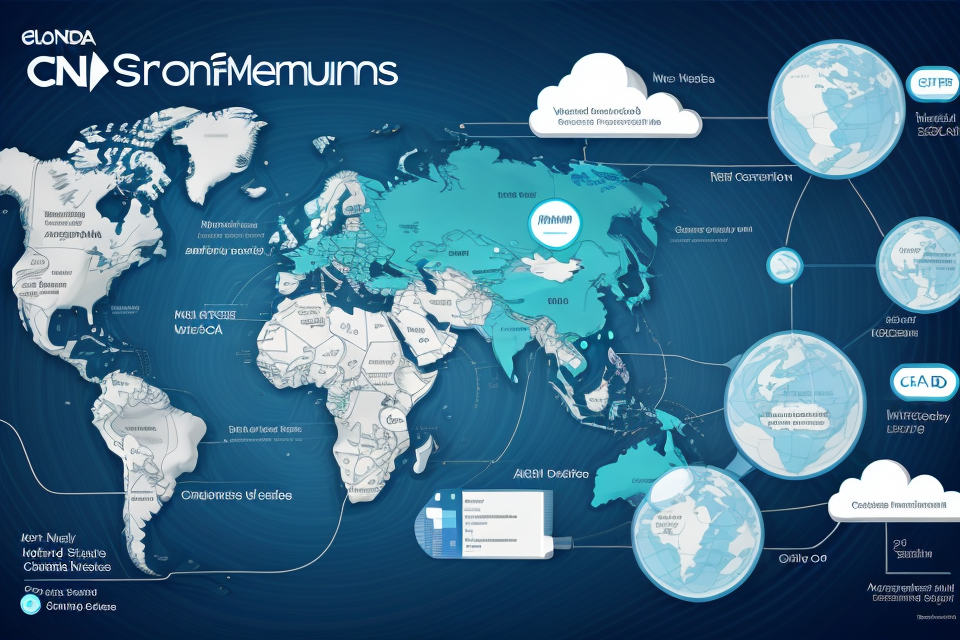Content Delivery Networks (CDNs) have revolutionized the way we access online content. They ensure that websites load faster, reduce latency, and improve user experience. But have you ever wondered where all this data is stored? In this article, we will explore the different data storage strategies employed by CDNs and their impact on performance. Get ready to delve into the fascinating world of data storage and discover how CDNs keep your favorite websites at your fingertips.
How Content Delivery Networks Function
Understanding CDN Architecture
CDNs, or Content Delivery Networks, are complex systems that rely on a distributed architecture to deliver content to users. This architecture is based on a network of servers located in different geographic locations, which work together to provide fast and reliable content delivery.
CDN nodes and caching
CDN nodes are the building blocks of a CDN architecture. These nodes are distributed across the network and are responsible for delivering content to users. Each node is connected to multiple servers, which allows them to distribute the load and ensure that content is delivered quickly and efficiently.
CDN nodes rely on caching to improve content delivery times. Caching involves storing a copy of the content on a server that is located closer to the user. This allows the user to access the content more quickly, as they do not have to wait for the content to be delivered from a distant server.
Distributed cache
Distributed caching is a technique that is used to improve the performance of CDNs. In this technique, each node in the CDN network maintains a local cache of frequently accessed content. When a user requests content, the CDN node checks its local cache first to see if it has a copy of the content. If it does, it can deliver the content from the cache, which reduces the time it takes to deliver the content.
Edge server cache
Edge server caching is another technique that is used to improve the performance of CDNs. In this technique, content is cached on servers that are located at the edge of the network, closer to the users. This allows the CDN to deliver content more quickly, as it does not have to rely on distant servers to deliver the content.
Edge server caching is particularly useful for delivering time-sensitive content, such as live streaming or online gaming. By caching content on edge servers, CDNs can reduce the latency associated with delivering this content, which can significantly improve the user experience.
Data transfer and delivery
Request-driven data transfer
When a user requests content from a website, the request is sent to the CDN server, which then forwards the request to the origin server. The origin server then sends the requested content back to the CDN server, which finally delivers the content to the user. This request-driven data transfer is the most common method used by CDNs.
Client request to CDN
When a user types in a URL, the request is sent to the CDN server. The CDN server then checks its cache to see if it has a copy of the requested content. If it does, it delivers the content directly to the user. If it doesn’t, it forwards the request to the origin server.
CDN to origin server
Once the CDN server receives the request from the user, it forwards the request to the origin server. The origin server then sends the requested content back to the CDN server.
CDN to client
After receiving the content from the origin server, the CDN server delivers the content directly to the user. This method ensures that the user gets the content quickly and efficiently.
CDN-powered data delivery
Another method used by CDNs is CDN-powered data delivery. In this method, the CDN server delivers the content directly to the user without forwarding the request to the origin server. This method is used when the CDN server has a copy of the requested content in its cache.
When a user requests content, the CDN server checks its cache to see if it has a copy of the requested content. If it does, it delivers the content directly to the user. This method ensures that the user gets the content quickly and efficiently.
Benefits of CDN-powered data delivery
The benefits of CDN-powered data delivery include faster delivery times, reduced bandwidth usage, and improved scalability. By delivering content directly to the user, CDNs can reduce the time it takes for content to be delivered. Additionally, by caching content, CDNs can reduce the amount of bandwidth needed to deliver content, resulting in cost savings for both the CDN provider and the user. Finally, by delivering content directly to the user, CDNs can improve scalability by reducing the load on the origin server.
Where Does CDN Store Data?
CDN Data Storage Locations
Closest edge server
- The closest edge server is the first location where CDN stores data.
- This is done to ensure that the data is delivered to the end-users as quickly as possible.
- The data is stored on the edge server in the form of a cache, which can be easily accessed by the users.
- The benefits of storing data on the edge server include low latency, faster delivery, and improved user experience.
- However, there are limitations to storing data on the edge server, such as limited storage capacity and potential security risks.
CDN data center
- CDN data centers are the second location where CDN stores data.
- These data centers are strategically located across the globe to ensure that the data is delivered to the end-users in the shortest possible time.
- The data is stored in a centralized location, which makes it easier to manage and maintain.
- The benefits of storing data in a CDN data center include high storage capacity, improved security, and easy management.
- However, there are limitations to storing data in a CDN data center, such as higher latency and potential bottlenecks.
Cloud storage
- Cloud storage is the third location where CDN stores data.
- This type of storage is becoming increasingly popular due to its scalability and cost-effectiveness.
- The data is stored in remote servers, which can be accessed from anywhere in the world.
- The benefits of storing data in cloud storage include unlimited storage capacity, scalability, and cost-effectiveness.
- However, there are limitations to storing data in cloud storage, such as potential security risks and latency issues.
Factors Affecting CDN Data Storage Decisions
Factors Affecting CDN Data Storage Location
Traffic patterns
Global traffic distribution
The global traffic distribution is a critical factor that affects the data storage location of CDNs. CDNs have to ensure that the content is delivered from the closest edge server to the user, thus reducing the latency and improving the performance. This means that the data storage location has to be strategically placed to ensure that the content is delivered to the users in the shortest time possible.
Local traffic spikes
Local traffic spikes are another factor that affects the data storage location of CDNs. CDNs have to ensure that they can handle sudden surges in traffic without compromising on the performance or the user experience. This means that the data storage location has to be flexible enough to handle the changes in traffic patterns.
User proximity
Closest edge server
The closest edge server is the most critical factor that affects the data storage location of CDNs. CDNs have to ensure that the content is delivered from the closest edge server to the user to reduce the latency and improve the performance. This means that the data storage location has to be strategically placed to ensure that the content is delivered to the users in the shortest time possible.
CDN data center
The CDN data center is another critical factor that affects the data storage location of CDNs. CDNs have to ensure that the data is stored in the most secure and reliable data center to ensure that the content is delivered to the users in the shortest time possible. This means that the data storage location has to be strategically placed to ensure that the content is delivered to the users in the shortest time possible.
Cloud storage
Cloud storage is another factor that affects the data storage location of CDNs. CDNs have to ensure that the data is stored in the most cost-effective and scalable cloud storage to ensure that the content is delivered to the users in the shortest time possible. This means that the data storage location has to be strategically placed to ensure that the content is delivered to the users in the shortest time possible.
CDN Data Storage Optimization Techniques
Optimizing CDN Data Storage
Dynamic caching
Benefits of dynamic caching
Dynamic caching is a technique that involves the storage of frequently accessed content on a CDN node closest to the end-user. The benefits of dynamic caching include reduced latency, improved user experience, and better scalability. Dynamic caching helps to ensure that content is delivered quickly and efficiently to users, resulting in a faster and more responsive website.
Implementation of dynamic caching
Dynamic caching can be implemented in a number of ways, including the use of a content delivery network (CDN) and a content management system (CMS). The CDN acts as a distributed cache, storing copies of content on multiple servers across the globe. The CMS can be used to manage the caching of content, with rules and algorithms determining which content should be cached and for how long.
Load balancing
Benefits of load balancing
Load balancing is a technique that involves distributing traffic across multiple servers to ensure that no single server becomes overwhelmed. The benefits of load balancing include improved performance, increased scalability, and better reliability. Load balancing helps to ensure that content is delivered quickly and efficiently to users, even during periods of high traffic.
Implementation of load balancing
Load balancing can be implemented using a variety of techniques, including the use of a content delivery network (CDN) and a load balancer. The CDN acts as a distributed cache, storing copies of content on multiple servers across the globe. The load balancer is responsible for distributing traffic across these servers, ensuring that no single server becomes overwhelmed.
Content Delivery Network Services
Benefits of using CDN services
Content delivery network (CDN) services provide a range of benefits, including improved performance, increased scalability, and better reliability. CDN services help to ensure that content is delivered quickly and efficiently to users, even during periods of high traffic.
Top CDN service providers
There are a number of top CDN service providers, including Akamai, Amazon Web Services, and Cloudflare. These providers offer a range of services, including CDN hosting, CDN caching, and CDN optimization.
Edge Computing
Edge Computing Overview
Edge computing refers to the process of storing and processing data at the edge of a network, closer to the end-users. This technology allows for faster response times and reduced latency, making it a popular choice for content delivery networks (CDNs).
Benefits of Edge Computing
- Faster response times
- Reduced latency
- Improved user experience
- Cost savings
Challenges of Edge Computing
- Increased complexity
- Need for specialized hardware
- Security concerns
Integration with CDN
- Benefits of integrating edge computing with CDN
- Improved performance
- Increased scalability
- Better resource utilization
- Implementation of edge computing with CDN
- Deployment of edge servers
- Integration with existing CDN infrastructure
- Use of edge computing-specific protocols and APIs.
FAQs
1. Where does CDN store data?
CDNs typically store data in distributed servers located in different geographic regions. These servers are strategically placed to provide fast and efficient content delivery to users based on their location. CDNs use various data storage strategies, including caching, edge computing, and cloud storage, to optimize the delivery of content.
2. What is caching in CDNs?
Caching is a technique used by CDNs to store frequently accessed content in temporary storage, such as RAM or SSD, on the edge servers. This allows for faster delivery of content to users since the content can be accessed directly from the edge server without having to be fetched from the origin server. CDNs use algorithms to determine which content to cache based on factors such as popularity, recency, and user behavior.
3. What is edge computing in CDNs?
Edge computing is a data storage strategy used by CDNs to process and store content closer to the end-users. This allows for faster and more efficient content delivery since the processing and storage are done at the edge of the network, reducing the latency and load on the origin server. Edge computing also enables CDNs to provide value-added services such as video streaming, gaming, and IoT applications.
4. What is cloud storage in CDNs?
Cloud storage is a data storage strategy used by CDNs to store and manage content in remote data centers. This allows for scalable and flexible storage of content, enabling CDNs to handle large volumes of content and fluctuating traffic patterns. Cloud storage also enables CDNs to provide backup and disaster recovery services, ensuring high availability and reliability of content delivery.
5. How does CDN data storage impact website performance?
CDN data storage strategies have a significant impact on website performance since they enable faster and more efficient content delivery to users. By storing content in distributed servers located closer to the end-users, CDNs reduce the latency and load on the origin server, resulting in faster page load times and better user experience. Additionally, caching and edge computing enable CDNs to provide real-time and personalized content delivery, enhancing the user experience and engagement.



